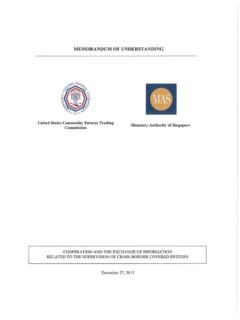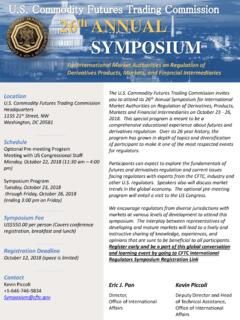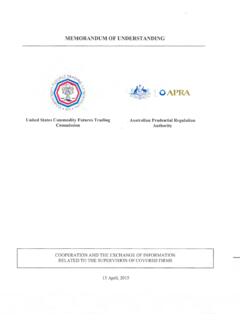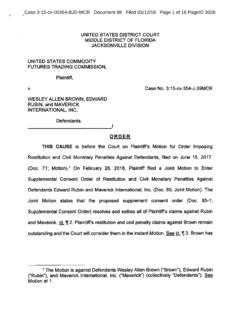Transcription of Traders in Financial Markets Explanatory Notes
1 1 Traders IN Financial FUTURES Explanatory Notes The Traders in Financial Futures (TFF), announced by the commodity Futures trading commission (CFTC) on July 22, 2010, builds on improvements to transparency implemented in 2009 that disaggregated data in the CFTC s weekly Commitments of Traders (COT) Reports. The new report separates large Traders in the Financial Markets into the following four categories: Dealer/Intermediary; Asset Manager/Institutional; Leveraged Funds; and Other Reportables. The legacy COT report separates reportable Traders only into commercial and non-commercial categories. The TFF report, like the COT reports, provides a breakdown of each Tuesday's open interest for Markets in which 20 or more Traders hold positions equal to or above the reporting levels established by the CFTC.
2 This report is published in futures-only and futures-and-options-combined formats. The TFF report is published side-by-side with the legacy COT. The TFF Report The commission , by regulation, collects confidential daily large-trader data as part of its market surveillance program. That data, which also support the legacy COT report, is separated into the following categories for the TFF report: 1) Dealer/Intermediary, 2) Asset Manager/Institutional, 3) Leveraged Funds, and 4) Other Reportables. Trader Classification The TFF report divides the Financial futures market participants into the sell side and buy side. This traditional functional division of Financial market participants focuses on their respective roles in the broader marketplace, not whether they are buyers or sellers of futures/option contracts.
3 The category called dealer/intermediary, for instance, represents sell-side participants. Typically, these are dealers and intermediaries that earn commissions on selling Financial products, capturing bid/offer spreads and otherwise accommodating clients. The remaining three categories ( asset manager/institutional; leveraged funds; and other reportables ) represent the buy-side participants. These are essentially clients of the sell-side participants who use the Markets to invest, hedge, manage risk, speculate or change the term structure or duration of their assets. Staff use Form 40 data1 and, where appropriate, conversations with Traders and other data available to the commission regarding a trader s market activities to make a judgment on each 1 The Form 40 is required under CFTC Regulation to be completed by reportable Traders .
4 Failure to file a Form 40, or failure to answer truthfully, is a violation of the commodity Exchange Act and CFTC regulations. Violators are subject to criminal or administrative sanctions. An updated Form 40 is requested of a trader every 2 years or more often at the discretion of CFTC staff if the trader remains reportable. The Form 40 is subject to audits or spot checks as conditions warrant. CFTC staff is available to large Traders and their representatives to answer questions about the proper way to complete a Form 40 and to help interpret it in unusual circumstances. 2 trader s appropriate Some multi-service or multi-functional organizations have centralized their futures trading . In such cases, their Form 40 may show occupations and market usages related to more than one of the new categories.
5 CFTC Division of Market Oversight (DMO) staff place each reportable trader in the most appropriate category based on their predominant activity. Some parent organizations set up separate reportable trading entities to handle their different businesses or locations. In such cases, each of these entities files a separate Form 40 and is analyzed separately for determining that entity s proper TFF classification. A trader s classifications may change over a period of time for a number of reasons. A trader may change the way it uses the Markets , may trade additional or fewer commodities or may find that its client base evolves, for example. These changes may cause DMO staff to change a trader s classifications and categories and/or change the commodities to which a trader s various classifications apply.
6 Moreover, a trader s classification may change because the commission has received additional information about the trader. Content of the Traders in Financial Futures (TFF) Report Dealer/Intermediary These participants are what are typically described as the sell side of the market. Though they may not predominately sell futures, they do design and sell various Financial assets to clients. They tend to have matched books or offset their risk across Markets and clients. Futures contracts are part of the pricing and balancing of risk associated with the products they sell and their activities. These include large banks ( and ) and dealers in securities, swaps and other derivatives. The rest of the market comprises the buy-side, which is divided into three separate categories: Asset Manager/Institutional.
7 These are institutional investors, including pension funds, endowments, insurance companies, mutual funds and those portfolio/investment managers whose clients are predominantly institutional. Leveraged Funds. These are typically hedge funds and various types of money managers, including registered commodity trading advisors (CTAs); registered commodity pool operators (CPOs) or unregistered funds identified by The strategies may involve taking outright positions or arbitrage within and across Markets . The Traders may be engaged in managing and conducting proprietary futures trading and trading on behalf of speculative clients. Other Reportables Reportable Traders that are not placed into one of the first three categories are placed into the other reportables category.
8 The Traders in this category mostly are using Markets to hedge 2 For example, staff may consider whether a trader is a member of the International Swaps and Derivatives Association (ISDA). 3 An unregistered fund may have a Part 4 exclusion from CTA/CPO registration or be a entity that is unregistered. So-called hedge funds are included in this category, regardless of whether they are registered. 3 business risk, whether that risk is related to foreign exchange, equities or interest rates . This category includes corporate treasuries, central banks, smaller banks, mortgage originators, credit unions and any other reportable Traders not assigned to the other three categories. Spreading The TFF sets out open interest by long, short, and spreading for all four categories of Traders .
9 Spreading is a computed amount equal to offsetting long and short positions held by a trader. The computed amount of spreading is calculated as the amount of offsetting futures in different calendar months or offsetting futures and options in the same or different calendar months. Any residual long or short position is reported in the long or short column. Inter-market spreads are not considered. Numbers of Traders The sum of the numbers of Traders in each separate category typically exceeds the total number of reportable Traders . This results from the fact that spreading can be a partial activity, so the same trader can fall into either the outright long or short trader count as well as into the spreading count. In order to preserve the confidentiality of Traders , for any given commodity where a specific category has fewer than four active Traders , the size of the relevant positions will be provided but the trader count will not be (specifically, a will appear for trader counts of fewer than four Traders ).
10 Historical Data Historical data for the TFF report will soon be available back to June 13, 2006. Note that the CFTC does not maintain a history of large-trader classifications, so, recent classifications had to be used to classify the historical positions of each reportable trader. Due to shifts in trader classifications over time (as discussed above), this backcasting approach diminishes the data s accuracy as it goes further back in time. Nonetheless, the data back as far as 2006 should be reasonably representative of trader classifications over that period. Comparison of the TFF Report to the Legacy COT Report and to the Disaggregated COT Report for Physical Commodities The legacy COT reports divide reportable Traders into the two broad categories of commercial and non-commercial.










